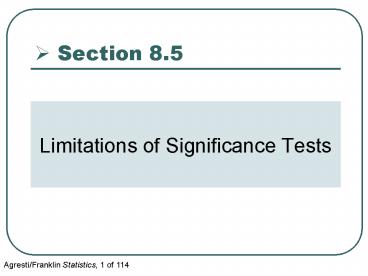Limitations of Significance Tests - PowerPoint PPT Presentation
Title:
Limitations of Significance Tests
Description:
A significance test merely indicates whether the particular parameter value in H0 is plausible ... little about which potential parameter values are plausible ... – PowerPoint PPT presentation
Number of Views:43
Avg rating:3.0/5.0
Title: Limitations of Significance Tests
1
Section 8.5
- Limitations of Significance Tests
2
Statistical Significance Does Not Mean Practical
Significance
- When we conduct a significance test, its main
relevance is studying whether the true parameter
value is - Above, or below, the value in H0 and
- Sufficiently different from the value in H0 to be
of practical importance
3
What the Significance Test Tells Us
- The test gives us information about whether the
parameter differs from the H0 value and its
direction from that value
4
What the Significance Test Does Not Tell Us
- It does not tell us about the practical
importance of the results
5
Statistical Significance vs. Practical
Significance
- A small P-value, such as 0.001, is highly
statistically significant, but it does not imply
an important finding in any practical sense - In particular, whenever the sample size is large,
small P-values can occur when the point estimate
is near the parameter value in H0
6
Significance Tests Are Less Useful Than
Confidence Intervals
- A significance test merely indicates whether the
particular parameter value in H0 is plausible - When a P-value is small, the significance test
indicates that the hypothesized value is not
plausible, but it tells us little about which
potential parameter values are plausible
7
Significance Tests are Less Useful than
Confidence Intervals
- A Confidence Interval is more informative,
because it displays the entire set of believable
values
8
Misinterpretations of Results of Significance
Tests
- Do Not Reject H0 does not mean Accept H0
- A P-value above 0.05 when the significance level
is 0.05, does not mean that H0 is correct - A test merely indicates whether a particular
parameter value is plausible
9
Misinterpretations of Results of Significance
Tests
- Statistical significance does not mean practical
significance - A small P-value does not tell us whether the
parameter value differs by much in practical
terms from the value in H0
10
Misinterpretations of Results of Significance
Tests
- The P-value cannot be interpreted as the
probability that H0 is true
11
Misinterpretations of Results of Significance
Tests
- It is misleading to report results only if they
are statistically significant
12
Misinterpretations of Results of Significance
Tests
- Some tests may be statistically significant just
by chance
13
Misinterpretations of Results of Significance
Tests
- True effects may not be as large as initial
estimates reported by the media
14
Section 8.6
- How Likely is a Type II Error?
15
Type II Error
- A Type II error occurs in a hypothesis test when
we fail to reject H0 even though it is actually
false
16
Calculating the Probability of a Type II Error
- To calculate the probability of a Type II error,
we must do a separate calculation for various
values of the parameter of interest
17
Power of a Test
- Power 1 P(Type II error)
- The higher the power, the better
- In practice, it is ideal for studies to have high
power while using a relatively small significance
level






























